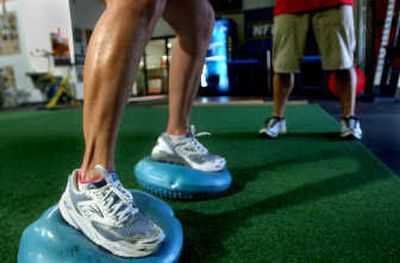Making it personal

At age 48, Julie Hurst can do pretty much anything an 18-year-old can. ■ “I can ride my bike for 30 miles, or I can go for an hour run,” she says.■ Insisting that she’s “not trying to be braggy or anything,” Hurst says there’s a secret to her success: She employs a personal trainer.
“I like to work out with someone, and I don’t have any friends who can go at it at the level I’m at now,” she says. “He pushes me to do things that I would never do on my own.”
That “he” is Travis Knight, head trainer for U-District Physical Therapy. Knight, 30, a former Gonzaga University baseball player, works with Hurst and a number of other clients, guiding them through exercises designed for each one individually.
Knight emphasizes the personal part.
“When you talk about improving your physical fitness, your physical self, there’s something bigger going on, whether it’s a phase of your life that you’re going through, whether it’s personal growth or getting back to a healthy you,” he says. “And I think that having a relationship is a big part of it for our clients.”
Anyone can read a book about training, consult the Internet or try to recall the tips once passed on by a favorite coach. Or we can simply buy a set of dumbbells and start pumping iron.
But there is particular value in consulting a personal trainer.
“As a personal trainer, I can help them a little easier than a book,” says Susie Rathbone, program director at the Gold’s Gym on North Nevada Street.
“It’s not all the same template,” Rathbone, 43, says of training methods. “It’s specific to them in terms of past injuries, what is their body type, what is their fat percentage, what is their past history or physical ability.”
Take Hurst. The mother of two didn’t do sports in high school. She started running when she was 18 just to get into shape.
“But that was about all I did,” she says.
Then she injured herself and turned to inline skating. And before long she began to race competitively. Over time, her growing sense of competition led her to a personal trainer.
“About 10 years ago, when I was racing, I just needed to improve my overall fitness and get my body fat down,” Hurst says.
She’s been working with Knight for the past 17 months, and she’s never been happier.
“I like when I go in there that every workout is different,” she says. “You aren’t doing the same weight-training regimen every day. You’re working on something totally different.”
More to the point, she likes how Knight pushes her.
“He makes you think that you can do it,” Hurst says. “He gives you the confidence. Some of the stuff that he has me doing I would never try on my own. … I just can’t make myself sore anymore, on my own.”
Hiring a personal trainer has become a national trend. According to the professional organization IDEA Health and Fitness Association, the personal training industry grew by 21 percent between 1996 and 2000.
The U.S. Bureau of Labor Statistics reports that personal training is No. 3 on the list of “Fastest Growing Occupations Requiring Post-Secondary Training,” and is expected to grow by 44 percent over the next five years.
If you are considering hiring a personal trainer, some questions to ask include:
1. Do they have a college degree in an exercise-related field? Or are they otherwise certified?
The point is to have “something that gives them a working knowledge of the human body,” says Knight, who doubles as strength coach for Gonzaga University’s men’s basketball team.
He holds a bachelor’s degree in physical education and a master’s in exercise science and is certified by both the National Strength and Conditioning Association and the American College of Sports Medicine.
Rathbone earned a bachelor’s degree in business administration. Along with her 20-plus years of experience, she is certified by two organizations: the International Sports Science Association and the National Exercise Trainers Association.
2. What experience do they have?
This is important, Rathbone says, “because if they’re brand new, they may not know how to work with people.”
Knight believes that experience goes along with both education and temperament because, he says, personal trainers have to deal with a wide range of “ages, injuries, goals, nutrition patterns and traveling lifestyles.”
3. What does it cost?
Fees for personal training depend on the facility and, in some cases, are added to normal membership fees.
U-District, which has no membership fee, charges between $10 and $55 an hour for personal training, depending on group size and other factors.
The North Side Gold’s, Rathbone says, charges $55 an hour (longer packages of five, 10 and 20 sessions offer slight discounts), though she has split the price between two clients who want to work with each other. Monthly membership fees range from $22 for individuals to $62 for families.
Be wary, Rathbone says, of trainers who “teach everyone the same routine and try to get as much money out of their clients by having them there forever.”
Ultimately, the fit between trainer and trainee is as personal as the style each trainer employs. The key comes from developing a relationship that is as trusting as it is inspiring.
“If you don’t have somebody to work out with, the likelihood that you’re going to stay with it is a lot lower,” Knight says. “So having a relationship with somebody who is going to hold you accountable is a pretty great feature.”
Hurst wants to make one thing clear: Knight’s support does help keep her in good shape, but she’s the one who has to sweat through the exercises.
“I have people say to me, ‘Oh, well, you have a personal trainer,’ ” she says. “And I say, ‘Yeah, but I still have to go and do the work. It’s not like he’s doing it for me.’ “